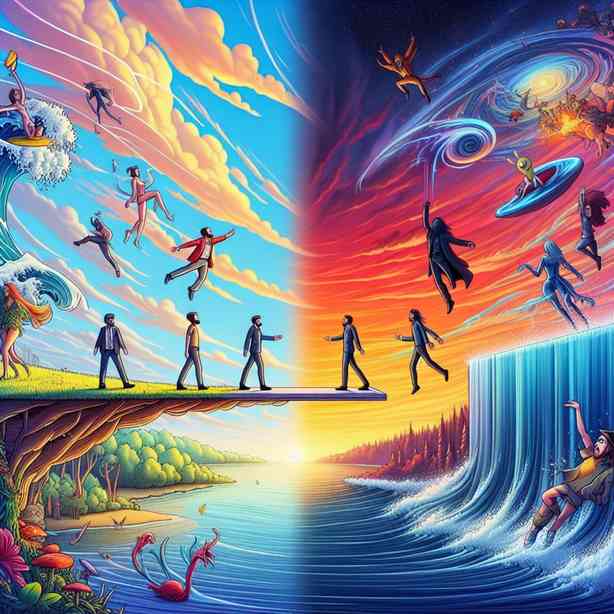
In the realm of storytelling, particularly within the context of animated media, there exists a unique phenomenon where the visual presentation of animated sequences can sometimes overshadow the underlying narrative logic. This is a well-observed situation in which audiences find themselves captivated by stunning imagery or highly refined animation techniques, even when the storyline lacks coherence or fails to adhere to logical progression. In this exploration, we will delve into the intricate relationship between animation quality and narrative substance, exploring the implications of this phenomenon on audience engagement and overall reception.
To begin with, it is essential to understand that animation has evolved significantly over the years. From hand-drawn frames to the advanced computer-generated imagery we see today, animation has developed into a sophisticated art form that appeals to a diverse range of viewers. The technological advancements in animation have opened up new realms of creative possibilities, allowing storytellers to visualize their ideas in ways that were previously unimaginable. As a result, animation often stands out as a compelling medium for conveying emotions and actions, providing a rich visual experience that can immerse viewers in fantastical worlds.
However, as technology has progressed, there is a growing concern that the stunning visuals associated with high-quality animation may occasionally detract from narrative coherence. This is particularly evident in works where the animated sequences are intricately crafted but the underlying plot lacks depth or fails to engage the audience’s logical reasoning. In such cases, viewers might find themselves more focused on the visual spectacle than on the narrative itself, leading to a disconnect between what they see and what they understand.
One vivid example of this phenomenon can be observed in certain animated films and series that are visually striking yet narratively confusing. These productions often boast intricate character designs, vibrant color palettes, and fluid motion that can easily dazzle the viewer. However, when the plot lacks clear development, feels disjointed, or introduces illogical elements, it can create a gap between the audience’s visual enjoyment and their narrative satisfaction. The visuals may momentarily captivate them, yet they could leave the theater or finish the series feeling unsatisfied due to a weak narrative foundation.
This tension is further complicated by the phenomenon of spectacle versus substance. Many creators are acutely aware of the allure of high-quality animation and may prioritize stunning visuals over a thoughtful narrative, leading to a cycle in which aesthetic appeal takes precedence over storytelling. This prioritization can result in a product that dazzles on the surface but ultimately leaves audiences wanting more in terms of character development, thematic depth, and logical progression.
Moreover, the expectations of contemporary audiences have evolved alongside these advancements in animation. Viewers today often come to expect not only visual excellence but also compelling narratives that resonate on an emotional or intellectual level. As such, the disparity between animation quality and narrative substance can create a sense of frustration among viewers who are eager for a holistic experience that engages both the eyes and the mind.
It is essential for creators in the animation industry to strike a balance between these two elements—ensuring that their stunning visuals are backed by thoughtful storytelling. Films such as “Into the Spider-Verse,” which masterfully combines vibrant animation with a compelling narrative, serve as benchmarks for what is achievable when both aspects are harmonized. This film, in particular, exemplifies how animation can enhance storytelling, allowing viewers to be drawn into the world while simultaneously following a coherent, emotionally resonant plot.
In contrast, instances where animation outpaces logic illustrate the risks associated with an unbalanced focus. When animation moves beyond mere aesthetics to become a tool for conveying complex ideas and emotions, viewers are likely to respond more positively. Successful animation thrives not just on visual extravagance but also on the ability to weave together stories that feel authentic and engaging. This approach doesn’t merely lead audiences through a series of animated sequences; it invites them to fully invest in the narrative journey.
The implications of this phenomenon also extend to the critical reception of animated works. Critics and audiences alike often look to both visual artistry and narrative depth when evaluating the success of an animated project. A film that excels in animation but falters in storytelling may be met with mixed or negative reviews, while a production that achieves harmony between visuals and narrative often garners acclaim. This relationship emphasizes the importance of a cohesive approach in animation, influencing how creators are perceived within the industry.
Furthermore, it is vital for those engaging with animated content to cultivate a discerning view of the works they consume. While it is natural to be enchanted by the visual aspects of animation, audiences are encouraged to remain critical and reflective regarding the narratives presented to them. This approach not only enhances the viewing experience but also holds creators accountable for delivering quality storytelling alongside visual innovation.
In conclusion, the dynamic interplay between stunning animation and narrative logic presents a fascinating landscape for audiences and creators alike. While animation has the potential to mesmerize and transport viewers to breathtaking realities, it is the union of narrative depth and visual artistry that ultimately leads to the most fulfilling experiences. As technology continues to evolve and push the boundaries of what is possible, there lies tremendous potential for animated works to prosper, provided they maintain a balance that respects the intelligence and expectations of their audience. As we move forward, it will be intriguing to observe how this relationship develops and influences the future of animation as a narrative-driven medium.


